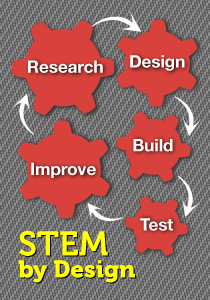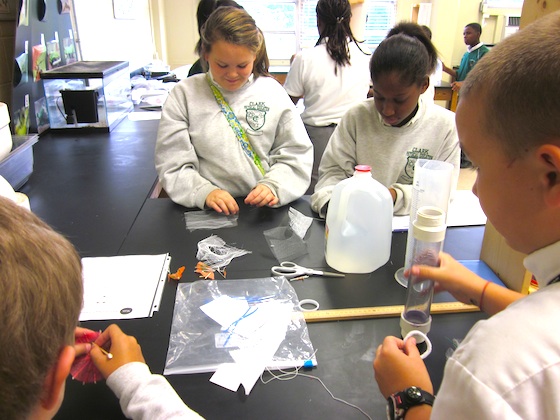3 Ways STEM Levels the Learning Field
A MiddleWeb Blog
I had just started my 8th grade earth science class when the door opened and in rolled a robot. Not a fancy robot, mind you, but a robot nonetheless. It was about 2 feet high, made of waxed cardboard, aluminum foil, a blinking red light, and wiring.
Marcus followed close behind, eagerly guiding his creation with a very DIY-looking remote control. Needless to say, the whirling, blinking device captured the undivided attention of the whole class.
I made a quick decision to pause my riveting lesson on the lithosphere, and I turned the class over to Marcus. The students were pumped by the sight of the robot and quizzed him in detail. What is it made of? How did you know how to make it? What are you going to do with it?
Marcus made the robot out of materials he was able to find around his grandmother’s house – string, cardboard, foil, wheels, etc. He had dismantled several electrical devices to get the wiring he needed. (He indicated that his grandmother was not too pleased about that.) With a little research and a lot of creativity, voila.
Several days later Marcus came to class displaying an electronic locking device for a doorknob that would keep anyone from entering his room without the code. Parts of the device looked familiar: waxed cardboard, foil, wiring, and a red blinking light. Marcus had been forced to scavenge his robot for the materials to create his locking device.
Marcus was an exceptional science student. He won first place in the science fair. Imagine my surprise when his other teachers came to me and remarked, “I’m glad Marcus is a good science student. He’s flunking my course.” (We teachers worked in isolation in those days. Teacher collaboration was barely a glimmer on the horizon.)
Marcus is why I’m so passionate about STEM today. For students such as Marcus, a true STEM program would have been a godsend.
Like so many of the kids in my classes, Marcus came from a low-income home. His grandmother worked at two low-wage jobs to buy food and keep a roof over their heads. He had entered school without the learning experiences and background knowledge of many of his peers, and he’d never experienced much success in traditional classrooms.
In spite of that, he was creative, intensely curious, and a good problem-solver, with a logical, scientific bent. Important traits of an engineer, in fact. With the proper education, Marcus would be an ideal candidate for the 21st century workforce.
What’s STEM got to do with it?
Why STEM? First of all, as Gloria Bonilla-Santiago writes in STEM and Urban Schools, STEM is where we know the jobs of tomorrow are, and people in inner cities need opportunities. Seven of the 10 projected fastest-growing occupations over the next decade are in STEM-related fields. Even in a time of high unemployment, the supply of open jobs exceeds the number of qualified STEM professionals to fill them.
Bonilla-Santiago says it well: “Add it all together, and you have the formula for opportunity. People in the inner cities need real jobs, not hourly wage work. STEM fields need skilled professionals. Sounds like a perfect fit, right?”
Right! And it’s up to K-12 schools to provide the foundation for that needed STEM workforce. Students living in low-income areas may actually benefit the most from participating in STEM coursework. These students must have access to high-quality STEM learning opportunities.
3 ways STEM can provide a level playing field
Consider this idea: a strong middle school STEM curriculum could provide a level classroom playing field for Marcus and other students in low-income circumstances in at least three ways:
1. Problem solvers. Students from low-income families often have life experiences which prepare them to recognize or anticipate problems, come up with solutions, create and test ideas, and see if these ideas work. When they participate in STEM projects these middle-schoolers are often prepared to contribute as much as other students to the actual STEM process. (See STEM and Math Teachers for a description of the process.)
2. All students start with STEM skill deficiencies. The hands-on nature of STEM requires students to find ways of successfully working together. Most of the students I taught were deficient in this skill; they all came in with little experience in real teamwork and collaboration. So students from all circumstances were more or less on equal footing from the beginning.
3. STEM is about showing what you can do with your mind and hands, relatively free of requirements that you have “insider” knowledge related to class or culture. The increased level of success that students from low-income families gain from hands-on STEM experiences can build confidence and self-esteem. This lays an academic and psychological foundation for students to take more challenging STEM coursework in high school and to seriously consider a technical or professional future.
STEM Equity: My favorite resource this week
I have a sense of urgency about how our middle schools can provide successful STEM programs. I’d like to share with you with my favorite resource for the week: Successful K-12 STEM Education: Identifying Effective Approaches in Science, Technology, Engineering, and Mathematics.
This free-for-download publication from the National Academies Press lays out some clear pathways schools and districts can follow to build successful STEM programs. It also identifies some barriers to equal access to high-quality STEM learning opportunities – things we can do something about such as disparities in teacher expectations, and access to adequate laboratory facilities, resources and supplies. These issues all contribute to gaps in science achievement for students from low socio-economic circumstances.
I don’t know what happened to Marcus after 8th grade. I understand he went to California to live with his mother. I’m hoping he’s in Silicon Valley surrounded by other entrepreneurs. I do know that the example of his potential has made me a determined advocate for STEM opportunities beginning early in the middle grades.































